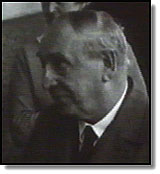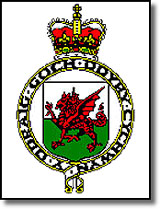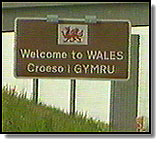

|
|
The Welsh flag... ...introduced as late as 1959 |
A Brief History of the Union of Wales and England
Wales has never been a united and independent country - though in its history its people have come close to achieving this aim several times.
The strife between the "English" and the "Welsh" goes back to times before the creation of any sense of a Welsh or English identity, when Celtic tribes in what is now Wales fought the Saxon invaders of England.
Back then Wales was a collection of minor kingdoms, united by language and culture but competing with each other. During the 9th century several Welsh noblemen allied themselves with King Alfred of England, an alliance which eventually led to Welsh dependence upon English protection.

|
| The Welsh Dragon once did bite |
But in 1283, the last independent Welsh princedoms were subjugated by Edward I. In the following centuries, large numbers of English settlers were moved into Wales, while the rights of the Welsh people were restricted.

|
| The Seal of Owain Glyndwr |
Wales was wholly assimilated into the English governmental system under Henry VIII. The Act of Union of 1536 (revised in 1543) established full equality for the Welsh people before the English law set today's borders between England and Wales and asserted that Wales had always been a part of England. In this respect England's Union with Wales differs from that with Scotland and its nature is also much closer to absorption.
English became the language for official business in Wales, the use of the Welsh language was actively discouraged, and at times penalised.
Welsh Nationalism
The Welsh nationalist movement before 1918 laid more emphasis on equality within the union, than separation from it. The rise of religious Nonconformity in Wales (the religious census of 1851 found that almost 80% of practising Christians in Wales were Nonconformist) in the early 19th century led to an identification between nationalism and the campaign for religious rights.
Then the nationalist's ultimate goal was not home rule, but the disestablishment of the Church of England in Wales. Education was also a significant issue - the creation of the University of Wales, a federation of the colleges of Bangor, Cardiff and Aberystwyth in 1893, was seen as an important symbol of national identity.
Welsh nationalism was additionally weakened by the growing differences between the country's North and West on the one hand and its more populated Southeast on the other, where the industrial revolution had caused drastic social changes.
As with Scotland it was franchise reforms which gave the Welsh the ability to achieve these aims. Welsh Nonconformists became an influential force within the Liberal party. Disestablishment and disendowment bills were introduced in 1894, 1895, 1909, and 1912-14.
In the early 1890s there were proposals to create a devolved Executive for Wales and to appoint a Secretary of State. Lloyd George, a Welshman who became Prime Minister during the First World War, urged home rule for Wales as early as 1891. However the Welsh Liberals were divided on the issue and when they were displaced by the Labour party in the 1920s, the nationalist movement became largely cultural.
Welsh Nationalism rarely turned to violence, with the exception of the "Sons of Glyndwr", a shadowy organisation whose members since the 1960s harassed and fire-bombed the homes of some "English settlers" and holiday homes of English owners in North Wales.

|
| Labour's James Griffith, the first Secretary of State for Wales |
First Steps Towards Devolution For Wales
After the Second World War a succession of governments acknowledged Wales as a separate political entity.
In 1948 the Labour Government created a Council of Wales but only to advise not to rule. A decade later, the Welsh Grand Committee was established consisting of all 40 MPs representing Welsh constituencies and five other Members nominated by the Selection Committee. It has the power to give bills relevant to Wales a second reading if given permission by the Commons and to hear statements by Welsh Office ministers.

|
|
The Welsh Office Y Ddraig Goch Ddyry Cychwyn The Red Dragon Leads the Way |
The Welsh Office and the post of Secretary of State for Wales were finally created in 1964, by a Labour government.
In 1978 the Labour Government introduced the Wales Act proposing to set up an assembly for Wales. But large parts of the Welsh Labour Party were opposed to the plan, and in a referendum the Welsh people voted four to one against the proposal.

|
| Playd Cymru currently has four MPs in Westminster |
Plaid Cymru - the "Party of Wales"
Plaid Cymru was formed in 1925. At first it was a movement more concerned with the preservation of the Welsh language than a political party. It won its first seat in the House of Commons in a by-election in Carmarthen in 1966, but lost it four years later. It gained Caernarfon and Meirionnydd in February 1974 and added Carmarthen in the October election of that year.
In the mid 1970s the party also made significant gains at local government level in the valleys of South Wales: between 1976-79 Plaid councillors gained outright control of Merthyr Borough Council and formed the largest group in Rhymney Valley.
In the 1987 General Election Plaid Cymru made its first parliamentary gain from the Conservatives by winning the island constituency of Ynys Mon (Anglesey) in Gwynedd. It won its highest ever share of the vote (17.1%) in the 1994 European election though it failed to win any seats.
Speaking Welsh
"Welsh" is an old Celtic language, closely related to the Breton of Brittany and Cornish of Cornwall, and more loosely connected to the Gaelic languages of Ireland and Scotland.

|
| One country - two languages |
By 1921 census figures show that only 37 per cent of Welsh people spoke Welsh. This figure has continued to decline gradually throughout the 20th century. The last census in 1991 established that 500 000 people were Welsh speakers, that is 18.5 per cent of the population.
Yet Welsh is far from being a dying language. It is taught in an increasing number of schools, and the number of children who speak Welsh is currently growing. A Welsh Office paper published in 1995 showed that 32.4 per cent of 3-15 year olds can speak Welsh.
The only areas where substantial proportions of the population speak Welsh are in the West and North-West of Wales. However, the largest numbers of Welsh speakers are in the cities of the South and of the western valleys of South Wales. The 1991 Census showed several towns with tens of thousands of speakers in South Wales, and only Bangor and Caernarfon approach this in the North.
Chronology
| 1282-3 | Edward I conquers Wales |
| 1400 | Rebellion of Owain Glyndwr begins (to 1410) |
| 1536 | First Tudor Act of Union with Wales |
| 1543 | Second Tudor Act of Union with Wales |
| 1832 | First Reform Act |
| 1867 | Second Reform Act |
| 1914 | Welsh Church Disestablishment Act passed |
| 1925 | Plaid Cymru formed |
| 1964 | First Secretary of State for Wales appointed |
| 1966 | Plaid Cymru wins its first by-election in Carmarthen |
| 1976 | Nov 28th: Scotland and Wales Bill published |
| 1979 | March 1st: Referendum held |


